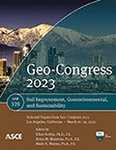Effectiveness of Microbial Induced Calcite Precipitation on Sand-Clay Mixtures
Publication: Geo-Congress 2023
ABSTRACT
Biocementation using microbial induced calcite precipitation (MICP) is a newly introduced and promising soil stabilization technique. In this process, ureolytic bacteria hydrolyze urea to give carbonate ions, which when combined with calcium-rich solution produces calcium carbonate that binds the soil particles together. The amount of calcite precipitate formed depends upon the pore size and hydraulic conductivity of the soil (keeping other factors the same). As the particle size decreases, the pore size and hydraulic conductivity both decrease, and hence the amount of induced calcite precipitate reduces. But the efficiency of this process not only depends on the amount of calcite precipitated but also depends upon how these precipitates bind the soil particles. In this study, the effectiveness of MICP on sand-clay mixtures of different proportions is investigated to find out the optimum gradation of sand-clay mixture for maximum efficiency of MICP treatment. A series of experiments were conducted to determine the unconfined compressive strength and induced calcium carbonate content of both treated and untreated clay-sand mixtures at various proportions. Test results indicated that as the amount of clay content increased in sandy soil, the size of the pore and hydraulic conductivity both reduced, leading to a reduction in the amount of induced calcium carbonate precipitation. The UCS of the treated samples showed better strength than the untreated samples. A post-treated sample with 20% clay soil shows 200 kPa more than an untreated sample of the same clay percentage. The improvement in strength between treated and untreated samples was reduced significantly after increasing the percentage of clay in sandy soil. At a higher amount of clay content, the MICP is restricted due to the improper growth of ureolytic bacteria and a lack of pores. The test results from this study provide an opinion about the applicability of the MICP on soil containing a significant amount of clay.
Get full access to this article
View all available purchase options and get full access to this chapter.
REFERENCES
Al Qabany, A., Soga, K., and Santamarina, C. (2012). “Factors affecting efficiency of microbially induced calcite precipitation.” J. Geotech. Geoenviron. Engng 138, No. 8, 992–1001.
Chou, C. W., Seagren, E. A., Aydilek, A. H., and Lai, M. (2011). “Biocalcification of sand through ureolysis.” J. Geotech. Geoenviron. Eng., https://doi.org/10.1061/(ASCE)GT.1943-5606.0000532, 1179–1189.
DeJong, J. D., et al. (2013). “Biogeochemical processes and geotechnical applications: Progress, opportunities, and challenges.” Geotechnique, 63(4), 287–301.
DeJong, J. T., Fritzges, M. B., and Nüsslein, K. (2006). “Microbial induced cementation to control sand response to undrained shear.” J. Geotech. Geoenviron. Eng., https://doi.org/10.1061/(ASCE)1090-0241(2006)132:11(1381), 1381–1392.
DeJong, J. T., Mortensen, B. M., Martinez, B. C., and Nelson, D. C. (2010). “Bio-mediated soil improvement.” Ecol. Eng., 36(2), 197–210.
Fujita, Y., et al. (2008). “Stimulation of microbial urea hydrolysis in groundwater to enhance calcite precipitation.” Environ. Sci. Technol., 42(8), 3025–3032.
Han, S., Wang, B., Gutierrez, M., Shan, Y., and Zhang, Y. (2021). “Laboratory study on improvement of expansive soil by chemically induced calcium carbonate precipitation.” Materials 14, no. 12: 3372.
Ivanov, V., and Chu, J. (2008). “Applications of microorganisms to geotechnical engineering for bioclogging and biocementation of soil in situ.” Rev. Environ. Sci. Biotechnol., 7(2), 139–153.
Karatas, I., Kavazanjian, J. E., and Rittmann, B. E. (2008). “Microbially induced precipitation of calcite using Pseudomonas denitrificans.” Proc., 1st Bio-Geo Engineering Conference, TU Delft and Deltares, Delft, The Netherlands.
Karol, R. H. (2003). Chemical grouting and soil stabilization, Marcel Dekker, New York.
Mitchell, J. K., and Santamarina, J. C. (2005). “Biological considerations in geotechnical engineering.” J. Geotech. Geoenviron. Eng., https://doi.org/10.1061/(ASCE)1090-0241(2005)131:10(1222), 1222–1233.
Mortensen, B. M., Haber, M. J., DeJong, J. T., Caslake, L. F., and Nelson, D. C. (2011). “Effects of environmental factors on microbial induced calcium carbonate precipitation.” J. Appl. Microbiol., 111(2), 338–349.
Stocks-Fischer, S., Galinat, J. K., and Bang, S. S. (1999). “Microbiological precipitation of CaCO3.” Soil Biol. Biochem., 31(11), 1563–1571.
van Paassen, L. A. (2009). Biogrout (ground improvement by microbially induced carbonate precipitation). Doctoral dissertation, Delft Univ. of Technology, Delft, The Nethelands.
van Paassen, L. A., Ghose, R., van der Linden, T. J. M., van der Star, W. R. L., and van Loosdrecht, M. C. M. (2010). “Quantifying biomediated ground improvement by ureolysis: Large-scale bio-grout experiment.” J. Geotech. Geoenviron. Eng., https://doi.org/10.1061/(ASCE)GT.1943-5606.0000382, 1721–1728.
Whiffin, V. S., van Paassen, L. A., and Harkes, M. P. (2007). “Microbial carbonate precipitation as a soil improvement technique.” Geomicrobiol. J. 24(5), 417–423.
Zhu, T., and Dittrich, M. (2016). “Carbonate precipitation through microbial activities in natural environment, and their potential in biotechnology: a review.” Frontiers in bioengineering and biotechnology: 4.
Information & Authors
Information
Published In
History
Published online: Mar 23, 2023
Authors
Metrics & Citations
Metrics
Citations
Download citation
If you have the appropriate software installed, you can download article citation data to the citation manager of your choice. Simply select your manager software from the list below and click Download.
